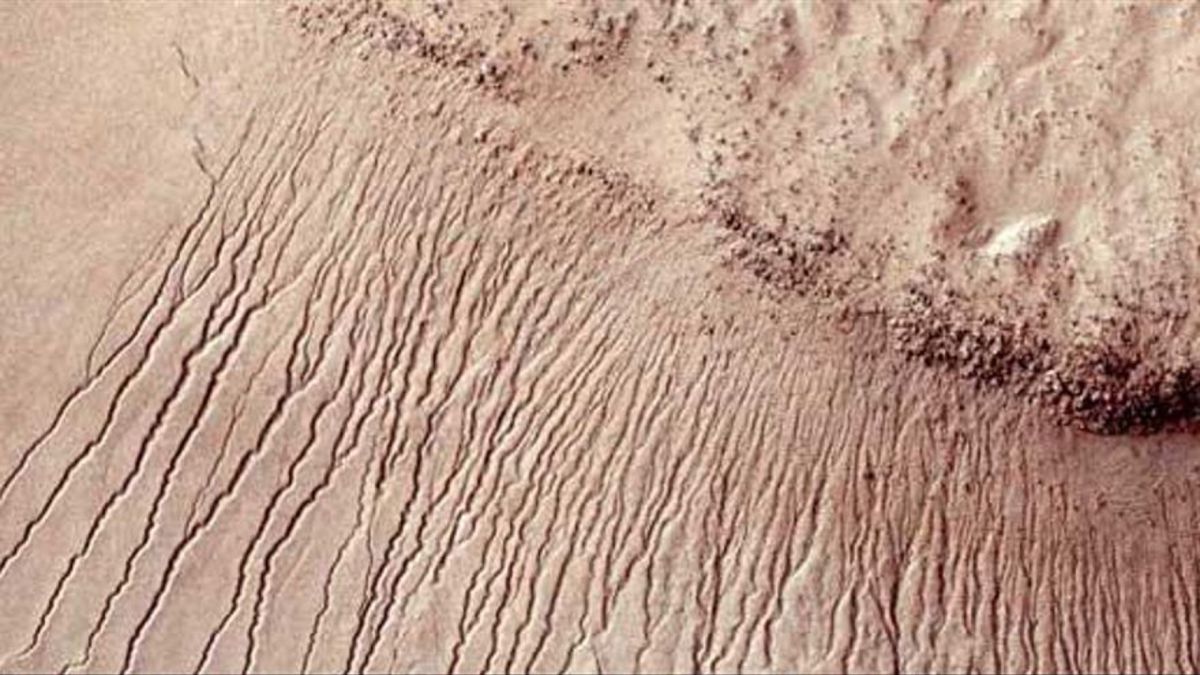Scientists continue to investigate to discover what causes the mysterious recurring seasonal grooves on the surface of Mars. Some theories suggest that fluids of liquid debris o go dry granular streams caused this movement, but none can fully explain the mysterious black lines, known as the Recurring Slope Lineae (RSL). However, now, a team of researchers from the SETI Institute have stoked the debate with a solid theory pointing to thawing as the main cause.
Scientists hypothesize that the melting ice in the regolith near the surface is provoking changes in the surface what they do vulnerable to wind and dust storms. As a result, the RSL features now appear and / or expand on the surface of Mars. Furthermore, they believe thin layers of melted ice are the resulting from interactions between groundwater ice, chlorine salts, and sulfates, which create an unstable mud that flows like a liquid causing sinkholes, soil collapse, surface flows and uplift.
“I am excited about the prospect of microscale liquid water on Mars in near-surface environments where there is ice and salts.”Janice Bishop, a planetary scientist at NASA’s SETI Institute and NASA Ames Research Center, and lead author of the study, said in a statement. Science Advances. “This could revolutionize our perspective of habitability just below the surface on Mars,” he adds.
Contradicts the brine hypothesis
Data from the Mars Reconnaissance Orbiter (MRO) High Resolution Imaging Science Experiment (HIRISE) show the RSL located on slopes facing the sun and in warmer regions. Some research claimed that these enigmatic dark stripes are signs that salt water is flowing regularly on the red planet during its warmer seasons, when salty brines capable, at least for a time, of remaining liquid in the cold air of the planet.
“However, geologists have discovered problems with the brine hypothesis that cause these stripes, ”Bishop explains in Space.com. For example, the angle of the slopes where these stripes appear and the characteristics that surround their origins “are largely inconsistent with a liquid flow process”Bishop told Space.com. In other words, its structure would not correspond to a flow of water falling down a hillside.
Bishop’s team’s theory is that subsurface chemical reactions could make the Martian surface vulnerable to landslides, causing these stripes. Although the surface of Mars today is dry, rough and cold and is dominated by wind and abrasion, below the surface they can still occur. Microscale interactions of salts with small particles of ice and liquid water”Says the expert.
Fundamental role of salts
The scientists relied on how salts interact with gypsum or groundwater, causing disruptions to the surface, including collapse and landslides. “On Earth, interactions between gypsum and chloride salts have caused the collapse of parts of some caves, sinks in soft sediments near lakes and salty ponds and the elevation of roads,” says Bishop.
To test their theory, the team conducted laboratory experiments to observe what would happen if analogous samples from Mars made up of chlorine salts and sulfates were frozen and thawed at low temperatures, like those that would be found on the red planet. The result was a formation of muddy ice near -50 ° C, followed by a gradual melting from -40 to -20 ° C. This suggests that these films could expand and contract over time, leading to upheavals and contractions beneath the Martian surface. Wind and dust could trigger landslides, producing the mysterious lines.
“I was excited to see such rapid reactions of water with sulfate and chlorine salts in our laboratory experiments and the resulting collapse and uplift of the analogue soil of Mars on a small scale, replicating geological collapse and uplift characteristics in karst systems, salt deposits and buildings collapse on a large scale ”, confesses the team leader.

